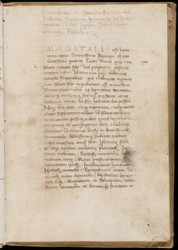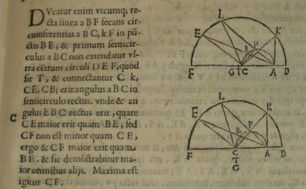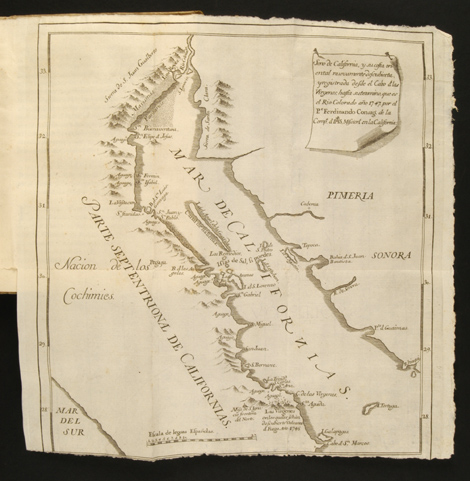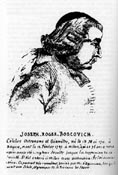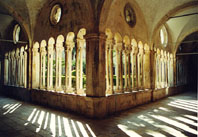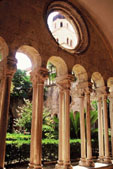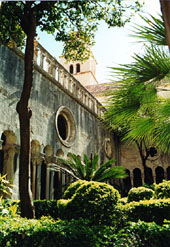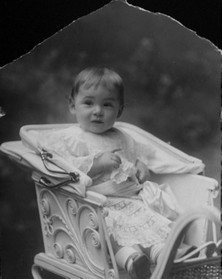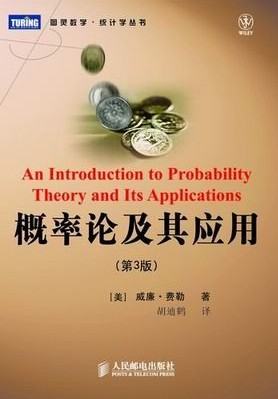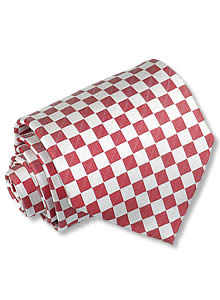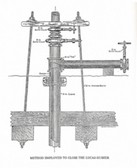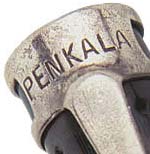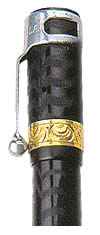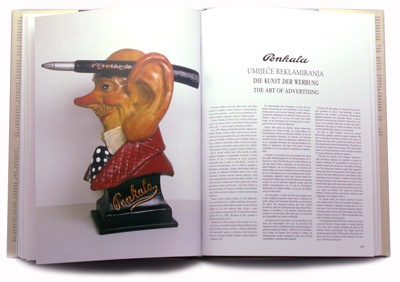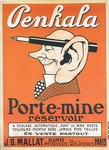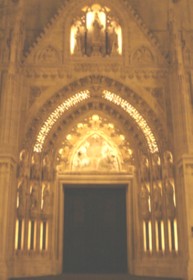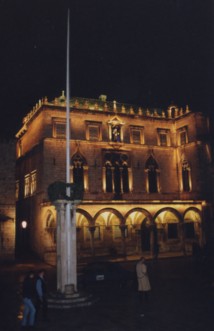SIESC 2007 in CROATIA
European Federation of Christian Teachers
Fédération Européenne d'Enseignants Chrétiens
Europäische Föderation Christlicher Lehrer/innen
You cannot report on half a century in a few pages...
Yves CALAIS, see History
of SIESC
An attempt to briefly describe some achievements of
Croatian Scientists and Inventors
Darko Zubrinic, Zagreb
The first known manual about book-keeping was Della mercatura e del mercante perfetto, (On merchantry and the perfect merchant) written in 1458 by Benko Kotruljic or Benedikt Kotruljevic (Benedictus de Cotrullis, born in Dubrovnik, 1416-1469). It is also the oldest known manuscript on double-entry. As such it precedes Luca Pacioli's description of double-entry for no less than 36 years, so that Kotruljic's priority is indisputable.
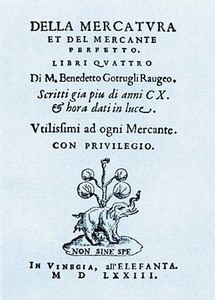
Kotruljic's famous 1464 manuscript on
book-keeping,
was printed in 1573 in Venice; editor and publisher was
another oustanding Croatian scholar - Franjo Petris
The French translation of Kotruljic's book appeared under the title "Parfait négociant" in Lyon in 1613.
In the book he states the following: "I declare that a merchant must not only be a good writer,accountant and book-keeper, but he also has to be a man of letters and rhetorician."
His another important manuscript is Benedictus de Cotrullis: "De Navigatione", 1464, written also in Italian. It is the first known manual on navigation in the history of Europe. Note that it appeared almost 30 years before the discovery of America. The book has been frequently copied throughout Mediteranean.

Benedictus de Cotrullis: De Navigatione,
1464;
photo from Beinecke
Rare Book & Manuscript Library
The original manuscript is kept at the University of Yale (in the Beinecke Rare Book and Manuscript Library, MS 557), and has 132 pp.
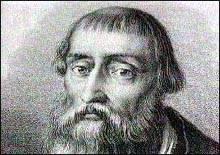 The first technical discoveries
are related to the name of Faust Vrancic (lat. Faustus
Verantius, italianized name Fausto Veranzio, hungarized name Faustus
Verancsics, 1551-1617). It is known that he collaborated with Tycho
Brache and Johannes Keppler. Vrancic was fluent in at least seven languages.
At the court of King Rudolph II in Hradcani in Prague (Rudloph II was
Roman-German Emperor and Croatian-Hungarian King) he worked as his secretary,
and in that period completed his important dictionary
of five most noble European languages (Dictionarium quinque nobilissimarum
Europeae linguarum: Latinae, Italicae, Germanicae, Dalmaticae et
Hungaricae) and published in Venice in 1595. He is best known for
his book of inventions in Machinae Novae, published also in Venice
in 1595. The book was financially supported by the French King Louis
XIII, and the Toscan Duke Cosimo II de Medici. Among his numerous inventions
the most famous is the parachute, which he tested in Venice. It
is true that Leonardo da Vinci had a similar idea earlier, but he made
only a rough sketch of it, of pyramidal shape, while Vranic's parachute
had rectangular shape, as today.
The first technical discoveries
are related to the name of Faust Vrancic (lat. Faustus
Verantius, italianized name Fausto Veranzio, hungarized name Faustus
Verancsics, 1551-1617). It is known that he collaborated with Tycho
Brache and Johannes Keppler. Vrancic was fluent in at least seven languages.
At the court of King Rudolph II in Hradcani in Prague (Rudloph II was
Roman-German Emperor and Croatian-Hungarian King) he worked as his secretary,
and in that period completed his important dictionary
of five most noble European languages (Dictionarium quinque nobilissimarum
Europeae linguarum: Latinae, Italicae, Germanicae, Dalmaticae et
Hungaricae) and published in Venice in 1595. He is best known for
his book of inventions in Machinae Novae, published also in Venice
in 1595. The book was financially supported by the French King Louis
XIII, and the Toscan Duke Cosimo II de Medici. Among his numerous inventions
the most famous is the parachute, which he tested in Venice. It
is true that Leonardo da Vinci had a similar idea earlier, but he made
only a rough sketch of it, of pyramidal shape, while Vranic's parachute
had rectangular shape, as today.
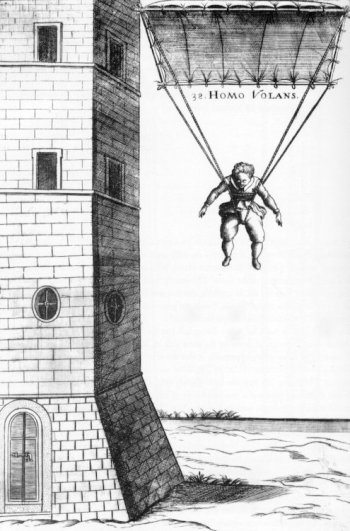

See Faust Vrancic (by dr. Vladimir Muljevic, in Croatian)
For example, the famous Verrazzano Narrows Bridge is the largest suspension bridge in the USA (New York, 1298 m), see also Historical Develpment of Iron and Steel in Bridges.
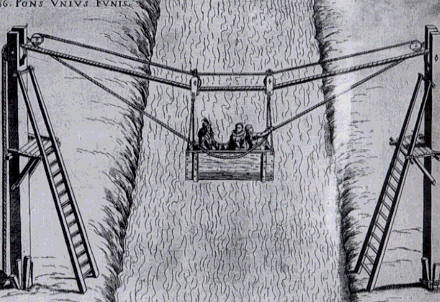
See Vladimir Muljevic: Hrvatski znanstvenici Antun i Faust Vrancic, Encyclopedia Moderna, god. 14, II, Zagreb, 1993. I express my sincere gratitude to Professor Emeritus V. Muljevic for this information.
Vrancic also described in his book Machinae Novae the first wind turbine:
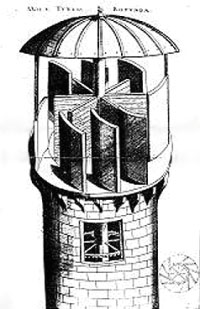
- in 1965 by "Heinz Moos Verlag", Munich, Germany (F. Klein, A. Wisner), translated into five languages,
- in 1968 by "Ferro", Milano, Italy (Umberto Forti), in Italian
- in 1985 by "Magveto", Budapest, Hungary, in Hungarian,
- in 1993 by "Novi Liber", Zagreb, Croatia
Marin Getaldic - Ghetaldus (1568-1622) born in Dubrovnik, was the most outstanding Croatian scientist of his time. He studied in Italy, England and Belgium. His best results are mainly in physics, especially optics, and mathematics. Among his numerous books let us mention Promotus Archimedus (Rome, 1603) and De resolutione et compositione mathematica (Rome, 1630, in five voluminous books), in which Getaldic appears as a pioneer of algebraization of geometry.
De resolutione et compositione mathematica libri qvinqvi(Rome, 1630, 343 pp., 22.5 x 31.8 cm), published eight years after his death; a detail from Lemma XXI; Getaldic is considered to be the main predecessor of Analytic Geometry.
His contributions to geometry had been cited by Christian Huygens and Edmond Halley.
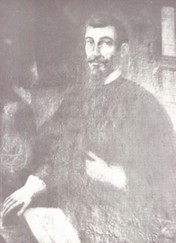
Marin Getaldic, a portrait kept in Rector's Palace in Dubrovnik
Getaldic is the constructor of the parabolic mirror (diameter 2/3 m), kept today in the National Maritime Museum in London. During his sojourn in Padova he met Galileo Galilei, with whom he corresponded regularly. He was a good friend to the French mathematician F. Viéte. The fact that the post of professor of mathematics had been offered to him in Louvain in Belgium, at that time one of the most famous university centers in Europe, proves his high scientific reputation.
Quite a number of Croats took part in the first Christian Missions, especially in South and North America and Asia. Ferdinand Konscak, or Fernardo Consag (born in Varazdin, 1703-1757), was a Jesuit and a Croatian missionary in North America. In 1752 he discovered that Baja California was not an island, as it had been believed until then, but a peninsula. There is a collection of rocky islets on the north of the Californian bay named in his honour as the Consag Rocks (Consag Rocas, or Roca de Consag, near San Felipe).
Denis Diderot and D'Alambert used some of his maps for the French Encyclopedia, see "Encyclopedie", Supplement 5 Carte (Paris 1755-1780), where his name is cited as P. Consaque. Alexander Humbolt used his maps for his "Carte generale... de la Nouvelle Espagne", Paris, 1804, and also Arrowsmith in his "Map of America", London 1805.
Konscak spoke various dialects of local Indians, in particular a very difficult dialect of Cochinin Indians. He described a sort of boomerang that Indians used for hunting rabbits. His diaries were printed already during his lifetime (published by Villa-Senor y Sanchez, Ortega-Balthasar and Venegas-Buriel), and after his death translated into many languages. The 1761 copy of Konscak's manuscript about California is held in The British Museum. His work Carta del P. Fernando Consag de la Compania de Jesus, Visistaro de las Misiones de Californias (43 pages) is kept in the British Museum in London, Library of Congress Harper in Washington, John Carter Library in Providence, Library of Pomona College in Pomona, Henry E. Huntington Library in San Marino.
His life is described by outstanding american historian Peter Masten Dunne in his monograph Black Robes in Lower California, Los Angeles, 1952. Seven copies of his maps are published by Ernest J. Burrus in his work La obra cartografica, Madrid, 1967. In his 2000 monograph Zoric proved that Konscak was the author of important work Addiciones a las noticias contemidas en la Description compnediosa de lo descuviert y conocido de la California. Since Konscak discovered many springs of pouring water, it is not surprising that even today there exist shops and warehouses in California bearing his name: "Licores Konsag", "Konsag Liquor Store and Mini Market", "Konsaqua" (agua purificada) etc.
The greatest and most famous Croatian philosopher and scientist Rudjer Boskovic (Boscovich, 1711-1787), was born in Dubrovnik, where he was educated in the Jesuit Collegium. He was a member of the Royal Society of London, a member of St.Petersbug Academy, "membre correspondant" of the French Academie Royale des Sciences, a member of the Accademia dell'Arcadia, a professor at many European universities. Very delicate work on repairing the cupola of St. Peter's church in the Vatican (diameter: 42m) was entrusted to R. Boskovic, a proof that he was a leading European authority for static computations and civil engineering of that time. Upon the request of Austrian Empress Maria Theresia, Boskovic was solving the problem of stability of Royal Library (now National Library) in Vienna.
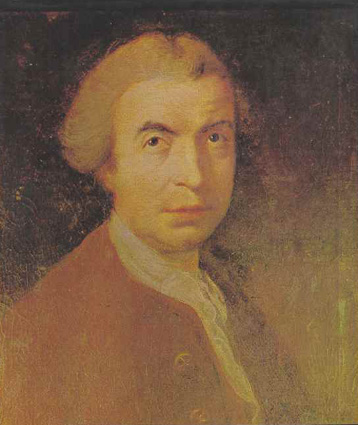
Portrait of Boskovic by the English painter Edge Pine (London, 1760).
He was also the founder of the astronomical observatory in Brera near Milan. In 1773 a charter granted by Louis XV made him a French subject. Soon he was appointed by Louis XV to a very prestigious position and became the Director of Naval Optics of the French Navy in Paris (Optique Militaire de la Marine Royale de France). He left to his adoptive country an achromatic telescope and micrometer. Boskovic spent nine years in France, and became a good friend to many outstanding scientist, like the mathematician Clairaut, Lalande, Buffon. When D'Alembert took him for Italian, he hastened to correct him.
Boskovic stayed 7 months in England and met many famous scientists there: James Bradley (famous astronomer), George Parker (president of the Royal Academy), Samuel Johnson (Lexicographer), Edmund Burke (philosopher and political writer), Joshua Reynolds (the first president of the Royal Academy of Arts), and others. It is interesting that in England he designed a telescope filled with water in all its components, which was implemented at the Greenwich observatory in 1871, that is, 84 years after his death. He also met Benjmanin Franklin, who showed him some of his electrical experiments, see an article by Branko Franolic.
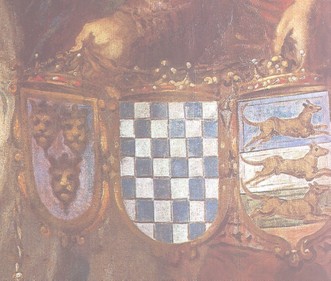
A detail from the Jesuit Collegium where R. Boskovic was educated,
17th century, representing coat of arms of
the Kingdom of Croatia, Slavonia and Dalmatia,
Boskovic was also a brilliant Croatian Latinist poet. He wrote an extensive scientific epic De solis et lunae defectibus (On Solar and Lunar Eclipse) published in London in 1760. It contains 5570 Latin verses, and was dedicated to the Royal Society of England whose member he was. In the title one can read "Father r. Boskovic, of the Jesuit Order", although at that time it was forbidden for Jesuits to live and work in England. The epic was written in the manner of Roman classics, in dactilus hexameter.
For more information see Latin as literary language among the Croats
When Charles Burney, a well known English musicologist, met Boskovic in Milan, he wrote: ...if all Jesuits were like this father, who uses the higher science and the work of mind to advance science for the happiness of mankind, then it were to be wished that this society were as durable as is this world. Boskovic was buried in the church of S. Maria Podone in Milano.
French astronomer Joseph-Jerome de Lalande wrote the following lines in his book Voyage en Italie:
Le plus grand mathématicen que l'aie connu à Rome est M. Boscovich, alors jésuite: il est né à Raguse en 1711, mais il vint à Rome étant encore fort jeune, et après avoir longtemps professé les mathématiques au collège romain il fut fait professeur à Milan et ensuite à Pavie; mais l'on voyait avec peine des talents supérieurs comme les siens, concentrés dans cette derniére ville; non seulement il n'y a personne en Italie dont les ouvrages soient aussi célàbres dans toute l'Europe que les siens, mais je ne connais pas de géomètre plus spirituel et plus profond que lui. Sa mesure de la terre, son beau traité sur la loi de la pesanteur, ses découvertes sur la lumière et sur diverses parties de la physisque, de l'astronomie, de la géométrie, son poème sur les éclipses, imprimé à Londres, à Venise et à Paris, peuvent doner une idée du nombre et de l'étendue de ses talents; mais il faut l'avoir connu particulérement, pour savoir combien il a de génie, combien son caractère est aimable, sa conversation intéressante, et ses idées sublimes dans tout les genres. En 1773, il a été appelé en France et naturalisé Français. Il est actuellement [1784] à Bassano, occupé à faire imprimer ses nouveaux ouvrages, en cinq volumes.
William Thompson-Kelvin, the English physicist (19/20 centuries), once expressed his opinion that his atomic theory is a pure "Boskovicianism." Still earlier, Sir Humphry Davy, professor of physics and chemistry at the Royal Institution in London from 1802 till 1827, mentioned the name of Boskovic on several occasions in his Diary (Commonplace Book), accepting his atomistic theory. The diary is kept in the archives of the Royal Institution in London. Also a famous Irish mathematician and physicist R.W. Hamilton wrote extensively about Boskovic's theory of forces.
With his theory of forces R. Boskovic was a forerunner of modern physics for almost two centuries. It was described in his most important book Theoria Philosophiae naturalis (Vienna 1758, Venice 1763, London 1922, American edition in 1966).
Werner Heisenberg (Nobel prize for physics in 1932) wrote the following:
Among scientists from the 18th century Boskovic occupies outstanding place as a theologian, philosopher, mathematician, and astronomer. His "Theoria philosophiae naturalis" announced hypotheses which were confirmed only in the course of last fifty years.Indeed, see his graph of regions of attractive and repelling forces between material points (elementary particles), the closest region being repelling, tending to infinity (nuclear force!; see here; published in his Dissertationes de lumine pars secunda, 1748), and the farthest region is repelling, corresponding to gravitational force:

Robert Marsh, the author of Physics and Poets, credits Boskovic with the idea of FIELD. Faraday and others took the idea from him, see here. He was the first to apply probability to the theory of errors. Laplace and Gauss acknowledged their indebtedness to his work which led to the Legendre principle of least squares in statistics (stating that the best fitting line is the one with the smallest sum of squared residuals).
He was also very active in astronomy and diplomacy. A great many letters sent to his sister and two brothers written in Croatian witness that he did not neglect his mother tongue. So in one of his letters he wrote that in one of European cities he saw soldiers - "our Croats" (nase Hrvate). He also wrote poetry. Most of his manuscripts are kept in the special Boskovic Archives in the Rare Books library in Berkeley, University of California, USA:- altogether 180 items and including 66 scientific treatises, plus
- rich correspondence comprising over 2,000 letters, among others with Euler, D'Alambert, Lagrange, Laplace, Jacobi and Bernoulli; he had intense correspondence with his friend Voltaire.
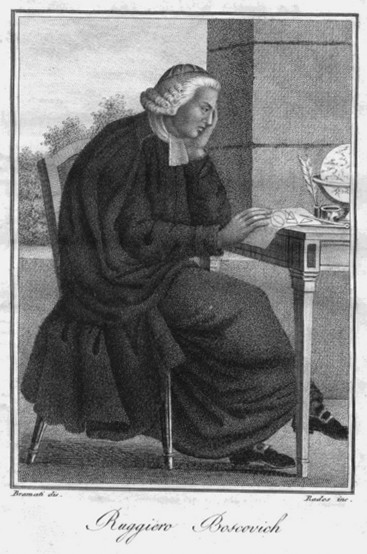
A portrait of Boskovic, published in
Milano in 1818 in a collection of famous
people living between 18th century the beginning of the 19th.
(many thanks to Dr Luca Leoni, Italy, for the photo)
Some of his books, articles and letters, together with other documents, are kept in the famous Franciscan monastery (Samostan Male Brace) in Dubrovnik. Its library possesses 30,000 volumes, 22 incunabula, 1,500 valuable handwritten documents. It was severely damaged in the aggression in 1991/92 (shelled by the Serbian Army - 37 direct hits).
One of the greatest English 20th century novelists Aldous Huxley, in Antic Hay (1923) mentions Boskovic, Leonardo, Michelangelo, Händel.
Filip Vezdin or Wesdin (Paulinus a Sancto Bartolomaeo, 1748-1806), pioneer of European indology, was born in a Croatian village of Cimov (Hof am Leithagebirge) in Lower Austria in Burgenland (Gradisce). He completed his studies of philosophy and theology, Roman languages and English in Linz and Prague. Besides native Croatian he spoke Latin, Greek, Hebrew, German, Hungarian, Italian, Portuguese and English. As a Carmelitan missionary (with monastic name Paulin of St. Bartholomew) Vezdin was sent to India in 1776, where he learned Sanskrit and several Indian dialects.
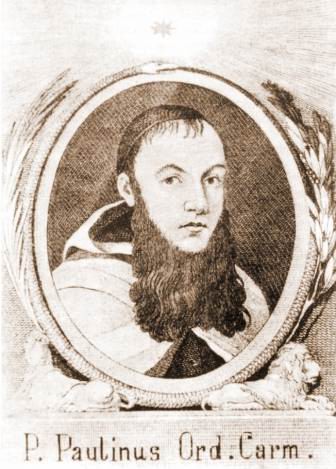
For more information see Filip Vezdin (in Croatian)
Vezdin is the author of Sidharubam seu gramatica samscrdamica, the first printed Sanskrit grammar in Europe, published in 1790 in Rome. Extended edition was published in 1804 and entitled Vyacarana seu locupletissima samsrdamicae linguae instituio.
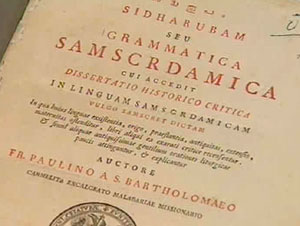
The first printed Sanskrit grammar
in Europe, written by Filip Vezdin in 1790,
photo from volksgruppen.orf.at/hrvati/visti/stories/45925/
He wrote numerous works on Indian culture, and in addition to Sanskrit also learned Malayalam, the Malabar coastal language, in which he wrote his works as well. At the request of a local ruler, King Rama Varmer of the Travancore, he wrote an English-Portugese-Malayalam grammar. The King, enthusiasted with Vezdin's fluency in Malayalam, asked him to be his teacher of English and Portuguese in his palace in Padmanabpuram. Vezdin's works are kept in Rome, Vienna and Uppsala. The first methodical study of connections between Indo-European languages is contained in his work De antiquitae et affimitate lingaue zendicae, samscrdamicae et germanicae disseratio, Rome 1798.
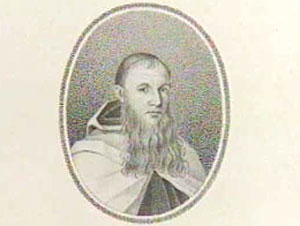
Filip Vezdin, pioneer of European
indology,
photo from volksgruppen.orf.at/hrvati/visti/stories/45925/
Vezdin's best known work is Systema brahmanicum liturgicum, mythologicum, civile ex monumentis Indicis Musei Borgian Velitris, Rome 1791, dealing with literature, mythology and civil order of brahmanic India, customs and the way of life. His most interesting and most popular work is his travel-book Viaggio alle Indie orientali, Rome 1796. He also published two philological studies about connections between Hungarian and Laponian languages. Vezdin is considered as one of pioneers of European indology.
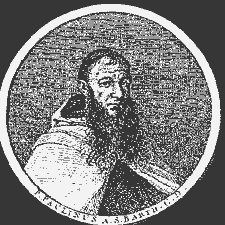
About twenty of his books were published already during his lifetime. Some of them were translated into German, French, English and Swedish. It is therefore no surprise that he was a member of the Royal Academy in Naples, and of the Academy "Dei Volsci" in Velletri and Padova.
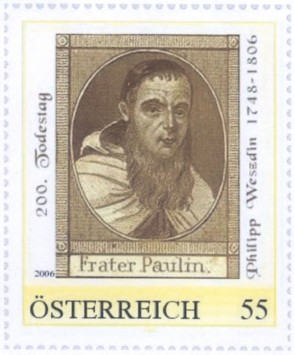
A postage stamp issued by a Cultural Association,
Hof
am Leithaberge, Austria in 2006, commemorating
200 years since Vezdin's death.
Many thanks to Dr Luca Leoni, Velletri.
In 2006 a memorial tablet dedicated to Filip Fezdin was placed in Velletri, a town near Rome, on the building of Museo Borgia (in Via della Trinita), where Vezdin had been working. The tablet mentions his Croatian descent: "Croato del Burgenland". Also, on that occasion an Italian translation of the monograph written by Dr. Branko Franolic about Filip Vezdin was promoted in the City Council of Velletri ("Paolino di San Bartolomeo, pioniere dell'indologia nell'Europa di fine Settecento", translated from the English original by Dr. Luca Leoni).
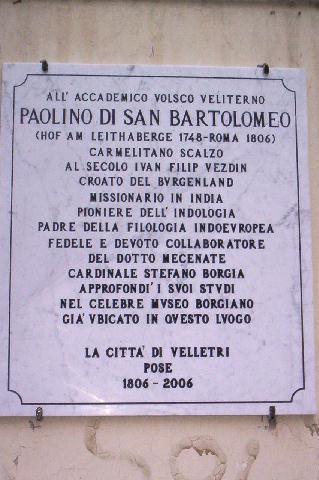
Memorial tablet dedicated to Filip
Vezdin in Velletri, Italy, 2006
Many thanks to Dr Luca Leoni, Velletri, for the photo and his translation:
TO
VELLETRI'S VOLSCIAN ACADEMIC THE CITY OF VELLETRI |
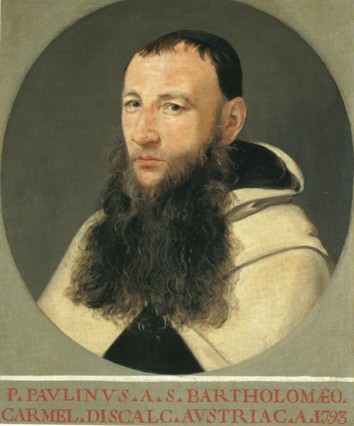
Filip Vezdin, portrait from 1793 probably
by J.H. Cabott (1754-1841),
once in cardinal Stefano Borgia's library in "Palazzo Altemps", Rome,
now conserved in "Propaganda Fide", Rome
(many thanks to Dr Luca Leoni, Velletri)
Vezdin's research gave a great impetus to investigation of culture and civilization of India in Europe. In 1999 Vezdin's image was carved into the white marble memorial plaque in the City Museum of Trivandrum, the capital of the Indian state of Kerala. Furthermore, the following text was written in the Sanskrit, Malayalam, Croatian and English languages on memorial tablet in the museum:
| Ivan Filip Vezdin, Burgenland Croat, Discalceate Carmelite, with the monastic name Paulin of St. Bartholomew, a missionary in Malabar from 1776 to 1789. The author of the first printed Sanskrit grammar and forerunner of Indian and Indo-European studies to the great honour of his homeland and the Croatian and Indian people. |
| Ivan Filip Vezdin, gradiscanski Hrvat, bosonogi karmelicanin, 1776. - 1789., misionarski je djelovao na Malabaru. Pisac prve tiskane sanskrtske gramatike i preteca indijskih i indoeuropskih studija na veliku cast svojoj domovini te hrvatskom i indijskom narodu. |
Among scientists studying seismology the famous Moho-layer (or Moho-discontinuity) of the Earth is well known. It was named after the great Croatian geophysicist Andrija Mohorovicic (born in Volosko, 1857-1936), professor at the University of Zagreb. His discovery was essential for understanding the inner structure of the Earth and the behavior of seismic waves. Together with the theory of forces due to Rudjer Boskovic, this is probably the greatest achievement in the history of Croatian science.
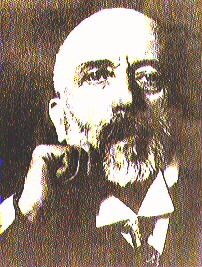
...As a boy of 15 he spoke Italian, French, and English as well as his native Croatian, later added German, Czech, Latin, and old Greek. He studied physics at the University of Prague under some famous professors including E. Mach and did his graduate work at the University of Zagreb, from which he obtained a Ph.D. In 1894 Dr. Mohorovicic became Director of the Institute for Meteorology and Geodynamics and Professor at the University of Zagreb in 1897, where he remained until his retirement in 1921. His special interest was the precise measurement of time for both astronomical and seismical events, but his reputation mainly rests on his classic paper in the field of seismology, The Earthquake of October 8, 1909, which contains the news of his discovery of a major discontinuity at a depth of 55 kilometers. This discontinuity, now generally known as the Moho in his honor, defines the crust of the earth. Professor Mohorovicic died in 1936 in circumstances approaching poverty.
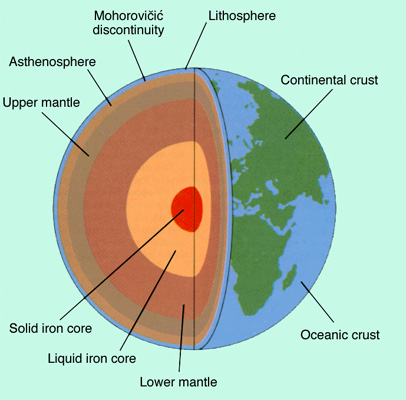
Photo from an article by Mete Oner: Deepest borehole ever drilled
Two Croatian names appear on the map of the Moon. The name of Rudjer Boskovic was given to a mountain on the visible side, and the name of Andrija Mohorovicic to a mountain on the dark side of the Moon.
William Feller (Zagreb, 1906 - New York, 1970) is outstanding Croatian - American mathematician. He graduated in mathematics from the University of Zagreb (1925), and earned his PhD in Göttingen (1926).
Vilibald Srecko Feller in 1907 (?), Zagreb;
with kind permission of prof. Marta Zdenkovic, Zagreb
Feller was university professor in Kiel, Copenhagen, Stockholm, and Lund. Since 1939 he lived in the USA, employed at Universities of Brown, Cornell, and Princeton. He is considered as one of the founders of the Theory of Probability as a scientific discipline, alongside with Moivre, Laplace, Poisson, Chebishev, Wiener, Kolmogorov and others.
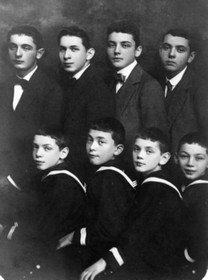 |
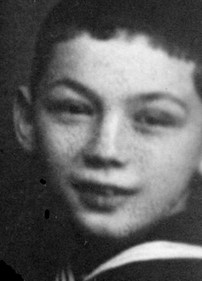 |
Vilibald Srecko Feller (bottom right), the youngest among eight brothers
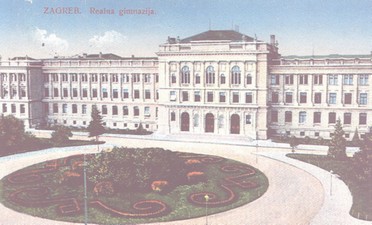
The First Gymnasium in Zagreb (now the Mimara
Gallery),
where Vilibald Srecko Feller finished his secondary shooling
(1922/23);
Feller is one of the founders of Probability Theory as a scientific discipline. He is best known for his two volume monograph An Introduction to Probability Theory and Its Applications, Princeton 1950, which is considered as one of the best mathematical textbooks of the 20th century.
A recent Chinese edition of Feller's monograph (first Chinese edition appeared in 1964)
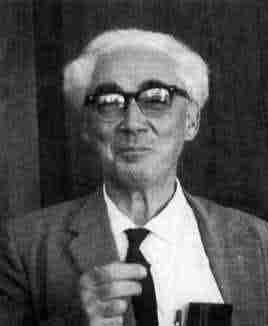
William Feller (1906-1970),
photo by Paul Halmos (1916-2006) from his book
I have a photographic memory (Providence, 1987)
Many mathematical notions bear his name:
|
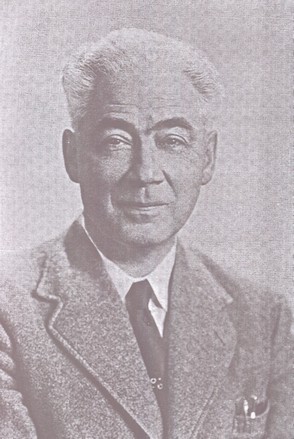
Vilim Feller, photo from [Vranic]
William Feller was a member of several national academies, including National Academy of Sciences, USA, and Croatian Academy of Sciences. He is recipient of the National Medal of Science from the President of the USA.
Fran Bosnjakovic (1902-1993), born in Zagreb, was one of world's leading experts in technical thermodynamics. Educated in Zagreb, where his scientific career started in 1926, he moved to Dresden, Germany, in 1928. In 1931 he became university teacher at Dresden High Mechanical Engineering School. After a short stay in Belgrade, he moved back to the University of Zagreb in 1936. After 1945, during the Yugoslav communist regime, he was degraded to two years of forced labor. In 1951 he became rector of the University of Zagreb.
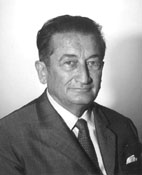 Since
1953 he started lecturing at the High technical school in Braunschweig in
Germany, where he became head of the Department for thermodynamics and director
of the Thermotechnical institute. In 1961 he founded the Institute of Thermodynamics
for Aeronautics and Astronautics at the University of Stuttgart, Germany,
that he led until his retirement in 1968. He also established groups for Irreversible
Thermodynamics, Mass Transfer and Thermokinetics, Radiation and Plasma, and
Heat Transfer. It is interesting that his textbook Technische Thermodynamik,
published already in 1935 in Dresden, had seven improved and extended editions
in Germany, and was translated into English (Technical Thermodynamics) and
Russian (Tehnicheskaya termodinamika). The Croatian translation had five editions
(Nauka o toplini). See his list
of publications held at the University of Stuttgart.
Since
1953 he started lecturing at the High technical school in Braunschweig in
Germany, where he became head of the Department for thermodynamics and director
of the Thermotechnical institute. In 1961 he founded the Institute of Thermodynamics
for Aeronautics and Astronautics at the University of Stuttgart, Germany,
that he led until his retirement in 1968. He also established groups for Irreversible
Thermodynamics, Mass Transfer and Thermokinetics, Radiation and Plasma, and
Heat Transfer. It is interesting that his textbook Technische Thermodynamik,
published already in 1935 in Dresden, had seven improved and extended editions
in Germany, and was translated into English (Technical Thermodynamics) and
Russian (Tehnicheskaya termodinamika). The Croatian translation had five editions
(Nauka o toplini). See his list
of publications held at the University of Stuttgart.
Professor Bosnjakovic obtained honorary doctorate from High Technical School RWTH Aachen, Grashof's medal from the German Society of Engineers VDI in 1969, gold medal from the Associazione Termotechnica Italiana in Padova in 1966, another gold medal from the Institut français des combustibles et de l'énergie in Paris. On the occasion of his 80'th birthday in 1982 the German Society of Engineers VDI issued a special publication devoted to his scientific work. In 1987, on the occasion of his 85'th birthday, a solemn colloquium was organized by the Technical University of Stuttgart. Also, he was a member of
- Academies in Heidelberg (Heidelberger Akademie der Wissesnschaften),
- Braunschweig (Braunschweigsche Wissenschaftliche Gesellschaft),
- Assoziazione Termotecnica Italiana in Padova, 1966 (recipient of gold medal),
- Istituto Veneto di Scienze, Lettere ed Arti in Venice,
- honorable member of Institut International du Froid (International Institute of Refrigeration) since 1960,
- Institut francais des combustibles et de l'energie, 1970 (recipient of the medal),
- Croatian Academy of Sciences and Arts (1992, i.e., only after the fall of ex Yugoslavia, and a year before the death of Bosnjakovic).
Denn das Ingenierwessen is vor allem auch ein Beruf des Könnes und der verantwortungsvollen Gestaltung, wofür wissenschaftliche Grundlagen nur einen, wenn auch beachtlichen, notwendigen Teil bilden.
Lavoslav Ruzicka (1887-1976, born in Vukovar, of a Czech father and a Croat mother, attended the gymnasium of Osijek), obtained the Nobel Prize for discoveries in organic chemistry, professor at the Technische Hochschule in Zurich, Switzerland 1939; see Ruzicka links.
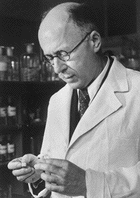
Vladimir Prelog, (1906-1998, a Croat born in Sarajevo, studied in Zagreb), obtained the Nobel Prize for discoveries in organic chemistry, worked at the Technische Hochschule in Zurich, 1975. As a young boy he was a stipendist of Napredak, Croatian cultural society in Bosnia and Herzegovina. See Prelog links. He wrote his authobiography, Vladimir Prelog: My 132 Semesters of Studies of Chemistry, American Chemical Society, Washington DC 1991 (second edition by Oxford University Press, Oxford, 1998). Prelog was among 112 Nobel Prize winner who signed and appeal For Peace in Croatia in 1992.
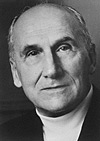
![]()
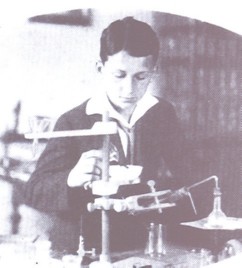
Croatian Medicine
Professor Andrija Stampar (1888-1958) was our leading authority in the field of epidemiology and a pioneer in preventive medicine. As an expert of the League of Nations he spent three years (1933-1936) in China, developing the health service there. During the WW2 he was arrested by the German Nazis and kept in custody in Graz in Austria. He was one of the founders of the World Health Organization (WHO) and very active in promoting the health service in Afghanistan, Egypt, Sudan and Ethiopia. He wrote the introductory declaration of the Statute of the WHO and was the first president of this organization. In 1948 Andrija Stampar was the chairman of the first WHO General Assembly in Geneva.
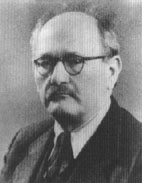
In 1955 he was awarded the medal of Leon Bernard, which is the most prestigious international acknowledgement in the field of social medicine. For more details see his book The first ten years of the World Health Organization, Geneva, 1958.
The most outstanding representative of the Croatian medicine, our specialist of international reputation in the field of othorhinolaryngology, was Ante Sercer (1896-1968). Due to his efforts a faculty of medical science was founded in Sarajevo in 1944. He was the editor in chief of our Medical Encyclopedia (the first edition appeared in ten volumes, over 700 pages each, in 1957-1965), which was one of the first in the world.
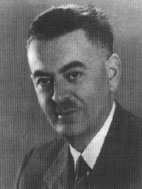
It is interesting to mention that the famous jazz trumpeter and singer Louis Armstrong-Satchmo was professor Sercer's patient in Zagreb, and was treated carcinoma of his lower lip in the sixties. He also cured Mario del Monaco and Giuseppe di Stefano.
Mirko Drazen Grmek (1924-2000), born in Krapina near Zagreb, was professor of history of medicine at the University of Zagreb, where he founded Institute for History of Science, and directed the first Croatian Medical Encyclopedia. Since 1971 he has been full professor at the Sorbonne in Paris, then associate professor of many European and American universities (Berkeley, Cambridge-Masachusetts, Geneva, Lausanne, Bologna, Rome, Zagreb), and finally Director of Studies at the École Practique des Hautes Études, Sorbonne, Paris.
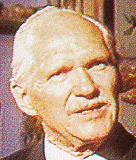
- Very important is Western medical thought from antiquity to the Middle Ages, a landmark work edited by Mirko D. Grmek.
- His monograph History of AIDS: Emergence and Origin of a Modern Pandemic, is winner of the George Sarton Medal of the History of Science Society.
- With Louise Lambrichs he wrote a monograph Les révoltés de Villefranche-de-Rouergue,
- and with Marc Gjidara and Neven Simac Le Nettoyage ethnique,
- Docteur Grmek - Ecrits autobiographiques et politiques de l'historien de la médecine,
- Mirko Grmek: La mémoire manipulée (Le Monde, 12/04/1991), Mirko Grmek est directeur d'études a l'École pratique des hautes études
In 1996 the international scientific journal Eureka called him physician of the century. The journal portrayed him with the following words:
Mirko Grmek is as famous among scholars throughout the world as he was unknown to the wider public. This Croat lived supporting the ideals to which he dedicated his entire life, namely that medicine must be practiced with full sense of conscience, and that science is simply another word if it is not accompanied by humanism.His particularly important books are
- Les maladies a l'aube de la civilisation occidentale, Payot, Paris 1983 (Deseases in the Ancient Greek World, John Hopkins Unversity Press, 1989)
- Histoire du sida, Payot, 1989 (History of AIDS, Princeton University Press, Princeton 1990; the first such book)
- (editor) Histoire da la pensée médicale en Occident, I, II, III, Seuil, 1995-1999 (Western medical thought from Antiquity to the Middle Ages Cambridge, MA, 1998)
- Le Legs de Claude Bernard, Fayard, 1997
- La vita, la malattia e la storia, Di Renzo Ed., Rome 1998 (French translation La Vie, les maladies et l'histoire, 1999).
His books (more than 30) are published in several languages: French, Italian, German, Polish, English, Croatian.
The SUVAG center for voice transmission for reeducation of speech disorders and deafness has been founded in Zagreb in 1961 by Academician Petar Guberina (1913-2005). The name of SUVAG is coined from Systeme Universel Verbotonal d'Audition Guberina.
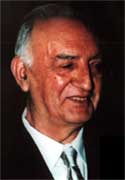
- Knighthood in 1968,
- the Officer’s Cross in 1989, which he was awarded in main quadrangle of the Sorbonne in Paris.
Petar Guberina earned his PhD in 1939 at Sorbone in Paris, and the title of his thesis was Valeur logique et valueur stilistique des propositions complexes en français et en croate.
Croatian Inventors
Cravate with a pattern of Croatian
coat of arms.
The name of "cravate" has been derived from the Croatian name.
- German - die Krawatte
- Italian - Cravatta
- Spanish - Corbata
- Portuguese - Gravata
- Croatian - Kravata
- Irish - Carabhat
- English - Cravat
- Swedish - Kravatt
- Finnish - Kravatti
- Flemish - Krawaat
- Danish - Kravat
- Polish - Krawat
- Ukrainian - Kravatka
- Czech - Kravata
- Slovakian - Kraváta
- Romanian - Cravata
- Turkish - Kravat
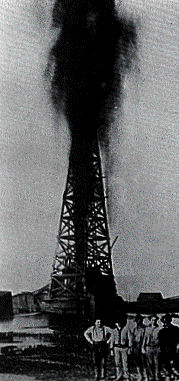 Antun Lucic (americanized
name is Anthony F. Lucas; born in Split 1855, died in Washington
1921)
discovered the first major gusher in Texas, The Lucas gusher, flowing
at the rate of 80,000 to 100,000 barrels per day. It blew in January 1901. About
50,000 people came to see it. This meant the earliest massive exploitation of
oil and petroleum in the world.
Antun Lucic, known as Anthony F. Lucas (F. = Francis is after his father
Franjo,
mariner and shipbuilder from the
island of Hvar) believed that the nearby Spindletop hill, near the town of Beaumont, covered a vast
pool of oil. His company became one of the first oil companies in Texas. Antun
Lucic was a mining engineer who completed his studies at the Polytechnic institute
in
Graz, Austria, where also his fellow countryman Nikola
Tesla later studied. By 1902, as many as 285 wells were operating on Spindletop
Hill and over 600 oil companies had been chartered (the population of Spindletop
sprang from 8,000 in 1901 to 60,000 in 1902, i.e. in just a year!). In this way
Captain Anthony Lucas enabled the United States to surpass Russia as the world's
leading oil producer. With the Lucas gusher, a black-gold rush began, and fortune-seekers
from all over the world poured into Texas. Over time, Houston became a center
of the oil
industry, and a captive of the British-dominated global oil cartel.
Antun Lucic (americanized
name is Anthony F. Lucas; born in Split 1855, died in Washington
1921)
discovered the first major gusher in Texas, The Lucas gusher, flowing
at the rate of 80,000 to 100,000 barrels per day. It blew in January 1901. About
50,000 people came to see it. This meant the earliest massive exploitation of
oil and petroleum in the world.
Antun Lucic, known as Anthony F. Lucas (F. = Francis is after his father
Franjo,
mariner and shipbuilder from the
island of Hvar) believed that the nearby Spindletop hill, near the town of Beaumont, covered a vast
pool of oil. His company became one of the first oil companies in Texas. Antun
Lucic was a mining engineer who completed his studies at the Polytechnic institute
in
Graz, Austria, where also his fellow countryman Nikola
Tesla later studied. By 1902, as many as 285 wells were operating on Spindletop
Hill and over 600 oil companies had been chartered (the population of Spindletop
sprang from 8,000 in 1901 to 60,000 in 1902, i.e. in just a year!). In this way
Captain Anthony Lucas enabled the United States to surpass Russia as the world's
leading oil producer. With the Lucas gusher, a black-gold rush began, and fortune-seekers
from all over the world poured into Texas. Over time, Houston became a center
of the oil
industry, and a captive of the British-dominated global oil cartel.
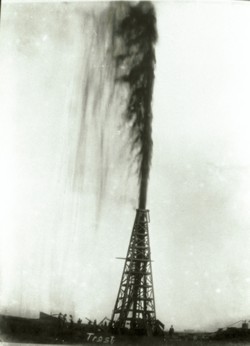
Anthony Lucas (Antun Lucic) invented the so called "Christmas tree", which is the system of valves and pipes installed on the wellhead to harness a gusher. The "Christmas tree" is connected to the piping for transportation or storage of oil.
Christmas tree invented by Anthony Lucas
in order to harness a gusher (photo from [McBeth])
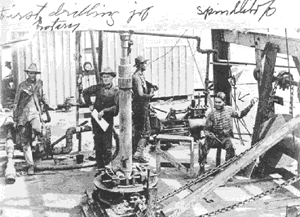
Anthony Lucas and drilling crew,
photo from Math/Science
Nucleus for children
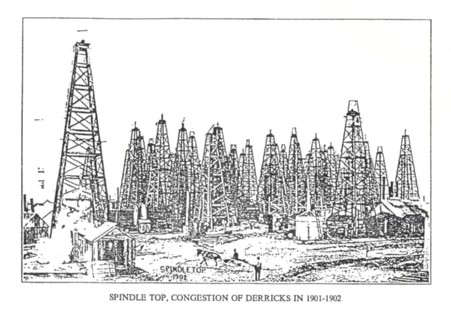
Spindle Top, congestion of derrics in 1901-1902 (photo from [McBeth])
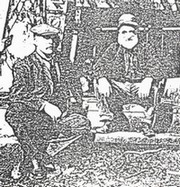
Antun Lucic (Anthony Lucas) on the left (photo from [McBeth])
The naval fuel board program adopted by the USA Government in 1901 specified that all the vessls should be equiped for the burning of oil as fuel. Railroads in increasing number were using it, and manufacturers were substituting it for coal and gas. At that time the automobile industry just began to develop, and the importance of Lucic's discovery for its further expansion was enormous.
Spindle Top in 1902
Antun Lucic is also considered to be the founder of modern petroleum reservoir engineering. He was consulting engineer in USA, Russia, Mexico, Algeria, and Romania. As an expert in mining he was elected the life long chairman of the American Committee for Oil and Gas (later called Petroleum Division, more information). In 1936 The American Institute for Geological and Metallurgical Investigations founded a prize named after him: Anthony F. Lucas Gold Medal.
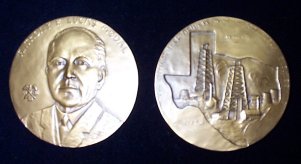
A museum with 18 m high granite obelisk was built in honour to the Lucas gusher in Spindletop. There is also 1,5 m granite monument of Lucic with inscription saying that his discovery revolutionarized industry and transport,... and changed lives of people in the whole world.
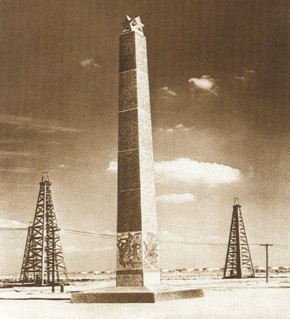
18 m high granite obelisk, built in honour
to the Lucas gusher, Spindletop, contains the following lines:
| On This Spot on the Tenth Day of the Twentieth Century a New Era in Civilization Began |
In 1943 Lucas' son and daughter-in-law established charitable foundation in his name.
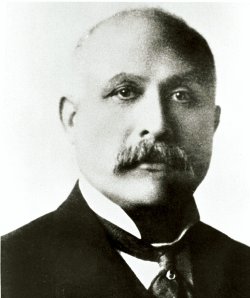
Antun Lucic (Anthony F. Lucas) is placed among 200 of most deserving Americans in the course of the entire history of the USA. There are a street and an Elementary school bearing his name in the City of Beaumont, Texas.
As to his nationality, it is often mistakenly described as Austrian, and sometimes even Italian (like in Who is Who in America, where there is also another mistake - that he was born in Trieste). On his grave in Rock Creek, Washington, he is said to be of Illiric origin, where Illiric is a standard name for Croatian. For more information about Anthony Lucas see here.
David Schwarz, a Zagreb Jew (1852-1897), invented steerable metal airship that is today unjustly bearing the name of the German count Zeppelin. Indeed, Zeppelin bought the complete project from Schwartz's wife, shortly after his premature death. It is true that in 1897 the `Zeppelin' constructed by Schwartz fell down during its trial flight near Berlin, due to a small technical error in the propeller, having reached the height of 460 m. It was 47.5 m long and had 35 tons.
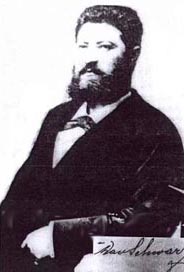
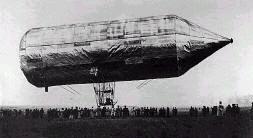
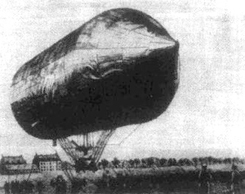
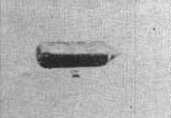
Photos from David Schwarz web site by Ante Sucur
The American Israel Numismatic Association issued two nice plaquettes in honour of David Schwarz, see here.The Croatian Jews left truly remarkable traces in arts, music, science and architecture.
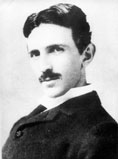 Nikola
Tesla (1856-1943), born in Croatia (at that time within Austria-Hungary),
is well known and need not be particularly introduced.
We feel it is necessary to cite his words that he was equally proud of his Croatian
motherland and Serbian descent. He completed his elementary and secondary school
education in Croatia (in Gospic and Karlovac), and studied in Graz and Prague.
He is the father of alternating electrical current technology and the three phase
system. He is equally known by his contribution to the high frequency technology
and wireless communications. The impact of Tesla's numerous inventions (112 patents
during his work in the USA) on the development of modern civilization is immeasurable.
The unit for magnetic induction Tesla, was named after him (Conference
general des poids et mesures, Paris, 1960). He refused to receive the Nobel prize
which he had to share with T.A. Edison.
Nikola
Tesla (1856-1943), born in Croatia (at that time within Austria-Hungary),
is well known and need not be particularly introduced.
We feel it is necessary to cite his words that he was equally proud of his Croatian
motherland and Serbian descent. He completed his elementary and secondary school
education in Croatia (in Gospic and Karlovac), and studied in Graz and Prague.
He is the father of alternating electrical current technology and the three phase
system. He is equally known by his contribution to the high frequency technology
and wireless communications. The impact of Tesla's numerous inventions (112 patents
during his work in the USA) on the development of modern civilization is immeasurable.
The unit for magnetic induction Tesla, was named after him (Conference
general des poids et mesures, Paris, 1960). He refused to receive the Nobel prize
which he had to share with T.A. Edison.
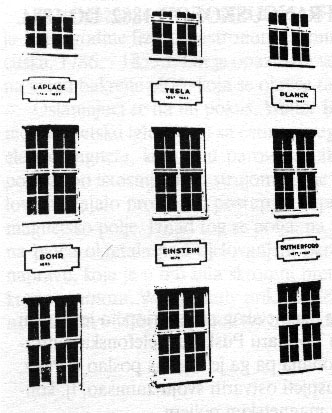 Windows of the building of Electricité de Strasbourg in
France, where Tesla had worked for some time, have inscriptions with names
of outstanding scientists. There you can see his name surrounded with Laplace,
Planck, Bohr, Einstein and Rutherford (click on the left). In front of the
building of International Union for Telecommunications in Geneva there is
a statue of Nikola Tesla. When his mother died, he paid a visit to Croatian
capital Zagreb in 1892, where he gave a lecture about alternating current.
On that occasion he said:
Windows of the building of Electricité de Strasbourg in
France, where Tesla had worked for some time, have inscriptions with names
of outstanding scientists. There you can see his name surrounded with Laplace,
Planck, Bohr, Einstein and Rutherford (click on the left). In front of the
building of International Union for Telecommunications in Geneva there is
a statue of Nikola Tesla. When his mother died, he paid a visit to Croatian
capital Zagreb in 1892, where he gave a lecture about alternating current.
On that occasion he said:
As a son of my homeland I feel it is my duty to help the city of Zagreb in every respect with my advice and work (Smatram svojom duznoscu da kao rodjeni sin svoje zemlje pomognem gradu Zagrebu u svakom pogledu savjetom i cinom; photo),
and suggested to build alternating current power plant. There is no doubt that by saying "homeland" he meant Croatia. In 1931, at the age of 75, Tesla received birthday greetings from Lee de Forest and Albert Einstein.
Eduard (Slavoljub) Penkala (1871-1922), born in Slovakia to a Polish/Dutch family, became naturalized Croat when after his marriage his family immigrated to Zagreb. He invented the mechanical pen in 1906 and fountain pen in 1907 which are bearing his name and now they are in everyday use.
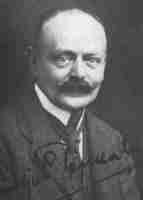
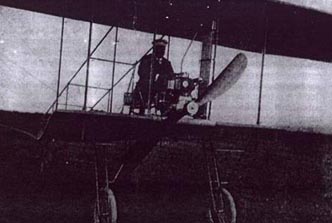
His first invention was a rasin bottle filled with hot water, called Termofor (hot water bottle), used in bed as "central heating" during cold nights.
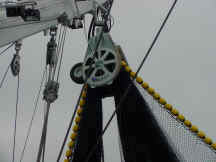 Mario
Puretic (1917, born in Croatia in Sumartin on the island of Brac),
revolutionarized the technology of pulling out fishing nets from the sea
by his construction of what is now known as the Puretic Power
Block in 1950s. Until then fishing nets had to be manually drawn
by eight to ten people, which was an extremely difficult job. The Marco
Seattle company developed Puretic's idea, and it soon became a standard
mean of fishing in the whole world. In 1975 the United States Patent Office
conferred him a special recognition for his patent which revolutionarized
the fishing technology worldwide. He was elected among hundred greatest
inventors of the 20th century in the USA. In 1972 the National Bank of
Canada issued a new series of 5 dollar banknotes with the Puretic Power
Block on a fishing boat drawn on the reverse side! For more details see
Mario
Puretic (1917, born in Croatia in Sumartin on the island of Brac),
revolutionarized the technology of pulling out fishing nets from the sea
by his construction of what is now known as the Puretic Power
Block in 1950s. Until then fishing nets had to be manually drawn
by eight to ten people, which was an extremely difficult job. The Marco
Seattle company developed Puretic's idea, and it soon became a standard
mean of fishing in the whole world. In 1975 the United States Patent Office
conferred him a special recognition for his patent which revolutionarized
the fishing technology worldwide. He was elected among hundred greatest
inventors of the 20th century in the USA. In 1972 the National Bank of
Canada issued a new series of 5 dollar banknotes with the Puretic Power
Block on a fishing boat drawn on the reverse side! For more details see
Adam Eterovic: Mario Puretic, the King of Purse Seine Fishing
From Marco Seattle web site: No single invention has contributed more to the success of purse seine net hauling than Marco's extensive line of Power Blocks. First introduced in the 1950's the Puretic Power Block line became the linch-pin in the mechanization of purse seining. Combined with fluid hydraulic power technology and new large synthetic nets, it changed the whole character of purse seine fishing. From those early days the Marco Power Block has undergone many design improvements to provide the widest available range of sizes and power options to match changing requirements.
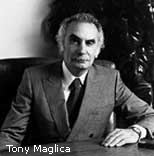 Anthony
Maglica, holder of hundreds of patents and trademarks,
founded Mag Instrument, Inc, in Los Angeles
in 1955, and
designed Mag-Lite flashlight, which is now an American product icon,
among 100 top products that "America makes best". The Maglite products have
been honored by the Japan Institute of Design and the Museum for Applied Art
in Germany. Mag
Instrument donated thousands of flashlights to aid in the rescue efforts at
the World Trade Center and Pentagon in 2001. Born in New York, and as a child
raised
in Croatia, Tony Maglica has plenty of other interests which include also Zlarin,
Croatia, where he
grew up.
Anthony
Maglica, holder of hundreds of patents and trademarks,
founded Mag Instrument, Inc, in Los Angeles
in 1955, and
designed Mag-Lite flashlight, which is now an American product icon,
among 100 top products that "America makes best". The Maglite products have
been honored by the Japan Institute of Design and the Museum for Applied Art
in Germany. Mag
Instrument donated thousands of flashlights to aid in the rescue efforts at
the World Trade Center and Pentagon in 2001. Born in New York, and as a child
raised
in Croatia, Tony Maglica has plenty of other interests which include also Zlarin,
Croatia, where he
grew up.
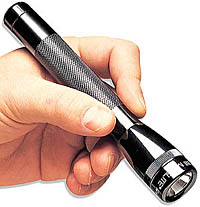
Agabekov SA is world's famous company seated in Geneva, Switzerland, dealing with exterior lighting design. Mr Youri Agabekov, the founder of the company, has Croatian roots: his father is Ladislav Zerjavic, from Hrvatsko Zagorje near Zagreb. His products have been used to cover with soft lighting such buildings like (photos by kind permission of Mr. Youri Agabekov):
- the Vatican
- Louvre, Paris
- Bolshoi Theatre, Moscow
- Saint Michel Bridge, Paris
- Palace of Sponza in Dubrovnik, Croatia
- Villa Astra in Lovran, Croatia
- Guernica by P. Picasso, Paris
- College de France, Paris
- Kingston Bridge, London
- Siltassari and Pitkäslita Bridges in Helsinki (Finland)
- Museum Arqueologic de Catalunya and Cathedral of Barcelona
- Cathedral of Palma de Mallorca, Spain
- Queen's Residence "Parlement" in Holland
- Princely Palace of Monaco
- National Museum Singapore
- Palacio National Mexico
- Banque Européenne in Bruxelles (Belgium)
- National Bank of Greece in Athens
- Bank of Luxemburg, etc.
Mr Youri Agabekov is a Croat born in Russia, living in Switzerland (Geneva) and in Croatia (Zagreb). His company, Agabekov SA, has 80 representatives throughout the world. Here is the logo of the company devoted to his wife Branka:
Light fixture, United States Patent 4158221 by Youri Agabekov; some of his patents are also held in Japan
Palace of Sponza, Dubrovnik
Ralph Tony Sarich (born in 1938) is an Australian Croat who developed the Orbital Engine in 1972. He is a recipent of several prestigeous ingeneering awards like Australian Inventor of the Year 1972, Sir Lawrence Hartnett Inventors Award 1972, Churchill Medal, British Society of Engineers 1987 and Clunies Ross National Science and Technology Award 1991. His parents are Croatian immigrants to Australia.
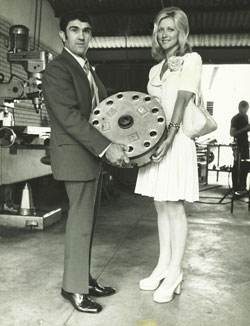
Miss Australia Michelle Downes visited Ralph
Sarich's workshop
where she was shown his revolutionary orbital engine in 1972.
Source business.thewest.com.au
The service of buying parking tickets via mobile phones is today widespread worldwide. The service has been conceived and developed in Croatia.
Marin Soljacic is the author of the new Wireless Power Transfer Technology, conceived in 1996. It attracted a substantial interest of the press (more than 200 articles in leading newspapers and radio-reports in numerous countries around the world, including: USA, Germany, Australia, Iran, India, Croatia, Greece, Spain, France, Italy, UK, Poland, Canada, the Netherlands, Thailand, Dominican Republic).
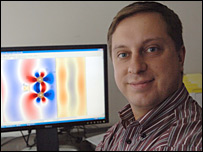
He is a young Croatian physicist born in the City of Zagreb, where he finished his secondary school education. Dr. Marin Soljacic is employed as researcher at the Department of Physics, Massachussetts Institute of Technology (MIT), USA. His father, Dr. Ivo Soljacic, is a very active member of HKDPD in Zagreb.
Croatia - France, an overview of cultural and historical relations - a sketch
